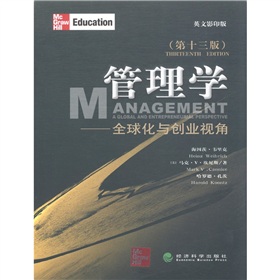管理学:全球化与创业视角 电子书下载 PDF下载

内容简介
《管理学:全球化与创业视角(第13版·英文影印版)》运用了大量的涉及美国、欧洲和亚洲(包括印度)的范例,探讨了适用于不同类型的组织和企业家的至关重要的管理原则和理念。正因如此,本书不仅是企业管理专业学生和教师得心应手的教材,而且也是企业管理人员不可多得的参考文献。
特色要点:
·每章都更新了反映当前形势的管理的国际化和创业视角。
·与硅谷地区著名创业家、风险资本家、高层管理人员和律师的近期访谈内容给管理原则赋予了耳目一新的内涵。
·全书增添了大鼙的聚焦于印度和中国的管理环境的案例和视角。
·补充了蓝海战略、平衡记分卡和启发式决策的新理论内容。
·价值链理念与管理的系统方法的结合。 ·查看全部>>
特色要点:
·每章都更新了反映当前形势的管理的国际化和创业视角。
·与硅谷地区著名创业家、风险资本家、高层管理人员和律师的近期访谈内容给管理原则赋予了耳目一新的内涵。
·全书增添了大鼙的聚焦于印度和中国的管理环境的案例和视角。
·补充了蓝海战略、平衡记分卡和启发式决策的新理论内容。
·价值链理念与管理的系统方法的结合。 ·查看全部>>
目录
Chapter 1
Figure l.1 Time spent in cattying out managetial functions
Figure l.2 Skills and managementlevels
Figure l.3 Approaches to management
Figure l.4 The management process, or operational, approach
Figure l.5 Input-output model
FigUfe l.6 Systems approach to management
Chapter 2
Figure 2.1 The organization and its external environment
Chapter 3
Figure 3.1 Forms of international business
Figure 3.2 The Baldrige award Cfiteria framework: dynamic relationships
Figure 3.3 The European Foundation for Quality Management model for business excellence
Figure Cl,1 TWOS Matrix for the competitive situation of China
Chapter 4
Figure 4.1 Close relationship of planning and controlling
FigUfe 4.2 Steps in planrung
Figure 4.3 Relationship of objectives and the Ofganizational hietarchy
Figure 4.4 Systems approach to management by objectives
Chapter 5
Figure 5.1 Sttategic plann/ng process model
Figure 5.2 TOWS Matrix for strategy formulation
Figure 5.3 Dynamics of the TOWS Matrix
Figure 5.4 Business portfolio matrix
Chapter 6
Figure 6.1 Bases for selecting from among alternative courses of action
Figure 6.2 The nature of problems and decision makingin the orgaruzation
Figure C2.1 TOWS matrix-A conceptual model
Figure C2.2 TOWS matrix for India
Figure C2.3 TOWS Matrix for Chrysler Corporation before the mergc
Figure C2.4 TOWS Matrix for Daimler-Benz before the merger
Figure C2,5 TOWS Matrix for Daimler-Chrysler after the merger
Chapter 7
Figure 7.1 Formal and informal organizations
Figure 7.2 0rganization structures with narrow and wide spans
Figure 7.3 Management by processes
Figure 7.4 The organizing process
Chapter 8
Figure 8.1 A functional organization grouping (in a manufacturing company)
Figure 8.2 A territorial, or geographic, organization grouping (in a manufacturing company)
Figure 8.3 Customer departmentation (in a large bank)
Figure 8.4 A product organization grouping (in a manufacturing company)
Figure 8.5 Matrix orgaruzation (in engineering)
Figure 8.6 Typical strategic business unit organization (in a large industrial chemical company)
Chapter 9
Figure 9.1 Centralization and decentralization as tendenaes
Chapter 10
Figure 10.1Formal and informal or informational organizations
Chapter 11
Figure 11.1 Systems approach to staffing
Figure 11.2 Managerinventory chart
Figure 11.3 Personnel actions based on manager supply and demand within the enterprise
Figure 11.4 Systems approach to selection
Chapter 12
Figure 12.1 The appraisalprocess
Figure 12.2 Formulation of a career strategy
Chapter 13
Figure 13.1 Manager development process and training
Figure 13.2 Analysis of training needs
FigUfe 13.3 Moving an organizational equilibrium
Figure 13.4 A model of the organization development process
……
Chapter 14
Chapter 15
Chapter 16
Chapter 17
Chapter 18
Chapter 19
Chapter 20
Figure l.1 Time spent in cattying out managetial functions
Figure l.2 Skills and managementlevels
Figure l.3 Approaches to management
Figure l.4 The management process, or operational, approach
Figure l.5 Input-output model
FigUfe l.6 Systems approach to management
Chapter 2
Figure 2.1 The organization and its external environment
Chapter 3
Figure 3.1 Forms of international business
Figure 3.2 The Baldrige award Cfiteria framework: dynamic relationships
Figure 3.3 The European Foundation for Quality Management model for business excellence
Figure Cl,1 TWOS Matrix for the competitive situation of China
Chapter 4
Figure 4.1 Close relationship of planning and controlling
FigUfe 4.2 Steps in planrung
Figure 4.3 Relationship of objectives and the Ofganizational hietarchy
Figure 4.4 Systems approach to management by objectives
Chapter 5
Figure 5.1 Sttategic plann/ng process model
Figure 5.2 TOWS Matrix for strategy formulation
Figure 5.3 Dynamics of the TOWS Matrix
Figure 5.4 Business portfolio matrix
Chapter 6
Figure 6.1 Bases for selecting from among alternative courses of action
Figure 6.2 The nature of problems and decision makingin the orgaruzation
Figure C2.1 TOWS matrix-A conceptual model
Figure C2.2 TOWS matrix for India
Figure C2.3 TOWS Matrix for Chrysler Corporation before the mergc
Figure C2.4 TOWS Matrix for Daimler-Benz before the merger
Figure C2,5 TOWS Matrix for Daimler-Chrysler after the merger
Chapter 7
Figure 7.1 Formal and informal organizations
Figure 7.2 0rganization structures with narrow and wide spans
Figure 7.3 Management by processes
Figure 7.4 The organizing process
Chapter 8
Figure 8.1 A functional organization grouping (in a manufacturing company)
Figure 8.2 A territorial, or geographic, organization grouping (in a manufacturing company)
Figure 8.3 Customer departmentation (in a large bank)
Figure 8.4 A product organization grouping (in a manufacturing company)
Figure 8.5 Matrix orgaruzation (in engineering)
Figure 8.6 Typical strategic business unit organization (in a large industrial chemical company)
Chapter 9
Figure 9.1 Centralization and decentralization as tendenaes
Chapter 10
Figure 10.1Formal and informal or informational organizations
Chapter 11
Figure 11.1 Systems approach to staffing
Figure 11.2 Managerinventory chart
Figure 11.3 Personnel actions based on manager supply and demand within the enterprise
Figure 11.4 Systems approach to selection
Chapter 12
Figure 12.1 The appraisalprocess
Figure 12.2 Formulation of a career strategy
Chapter 13
Figure 13.1 Manager development process and training
Figure 13.2 Analysis of training needs
FigUfe 13.3 Moving an organizational equilibrium
Figure 13.4 A model of the organization development process
……
Chapter 14
Chapter 15
Chapter 16
Chapter 17
Chapter 18
Chapter 19
Chapter 20
Copyright © 2024 by topbester.com.
All Rights Reserved.
沪ICP备14027842号-1
All Rights Reserved.
沪ICP备14027842号-1